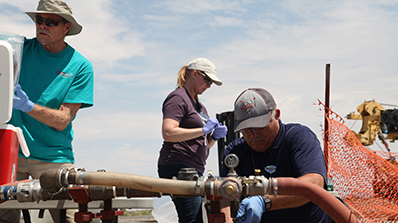The U.S. Department of Energy (DOE) Environmental Management (EM) Nevada Program recently recently reached a major milestone when its environmental program services contractor reached 3.5 million hours without a lost workday due to a safety incident. The period for Navarro Research & Engineering’s 3.5 million hours extends more than 16 years and multiple contracts and contract teaming partners. A lost workday is an occupational injury or illness that results in an employee being unfit for work following the incident.
“The successes in safety over multiple contracts can be attributed to consistent engagement of personnel at all levels in the organization in work planning and execution where hazards are identified and mitigated prior to and during project performance,” Navarro Environmental Safety and Health Manager Tom Bastian said.
The EM Nevada Program implements environmental corrective actions to address contamination resulting from historic nuclear testing at the Nevada National Security Site (NNSS) and surrounding Nevada Test and Training Range (NTTR).
EM’s mission in Nevada involves workplace hazards such as heavy machinery, radiological contamination, unexploded ordnances, work outdoors in excessive heat and extreme weather conditions, and slips, trips and falls that are a risk in every workplace.
Navarro employees who work at the NNSS and NTTR develop groundwater characterization wells, survey soils and industrial-type facilities for contamination, excavate land, and manage waste. Navarro adheres to DOE’s Integrated Safety Management System, which ensures safety is ingrained in management and work practices at all levels and stages of planning and execution.
In 2006, Navarro developed and implemented a safety leadership program as a corrective action and lesson learned derived from a previous lost workday incident. Safety leadership has become a model best practice, through which EM Nevada and Navarro personnel are regularly trained to understand safety culture expectations, think for themselves, consider consequences, and act with health and safety first and foremost in mind. Without exception, every day in the field starts off with both a daily operations call and a safety briefing, during which workers review procedures, acknowledge potential hazards, and address safety measures.
“Safety expectations are communicated with all personnel in safety leadership discussions, daily operation calls, and tailgate safety briefings. Safety issues or concerns are documented and addressed using a formal issues management system,” Bastian said. “These processes and employee commitment have been instrumental in the safe operations at EM Nevada.”
Another major component of EM Nevada’s safety culture is its experienced workforce. Many environmental program services contract employees have worked in various roles within the EM Nevada Program for decades. The unique hazards specific to their worksites are well known, and their experience gained over many years in the field helps prevent accidents.
Long careers spent working on EM Nevada Program missions have led to strong relationships between employees who have worked side by side for years. These relationships enable workers to recognize each other’s strengths and weaknesses, look out for one another, and respect each other’s instructions, cautions, and advice.
“Ultimately, a collaborative environment has been developed where workers take responsibility for their own safety as well as the safety of their co-workers, which has contributed greatly to EM Nevada and Navarro’s exemplary safety record,” Bastian added.

